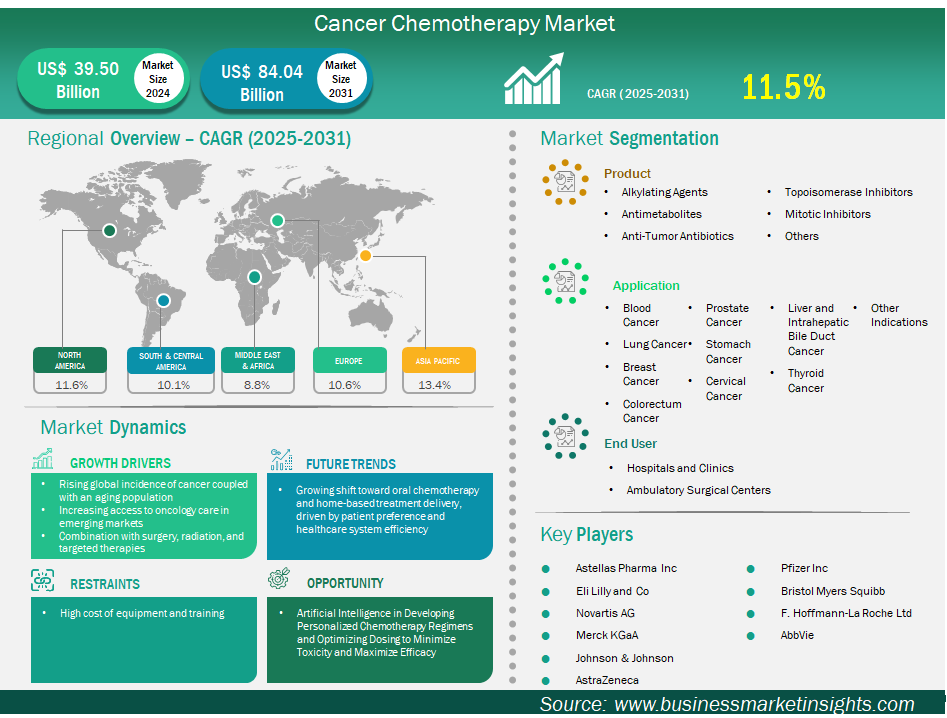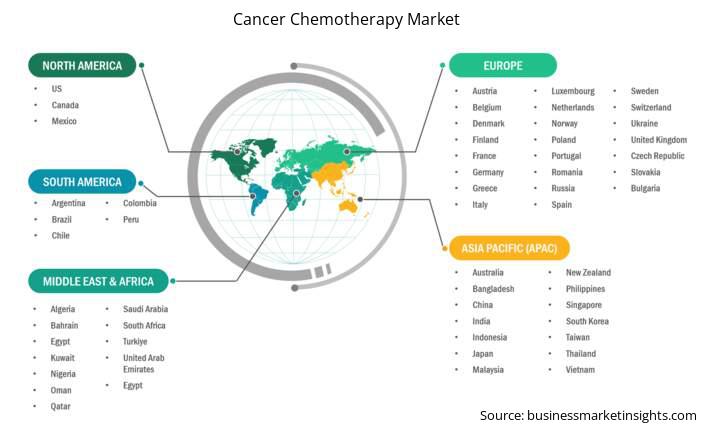Cancer Chemotherapy Market Outlook (2021-2031)
No. of Pages: 200 | Report Code: BMIPUB00031705 | Category: Life Sciences
No. of Pages: 200 | Report Code: BMIPUB00031705 | Category: Life Sciences
The cancer chemotherapy market size is expected to reach US$ 84,044.04 million by 2031 from US$ 39,509.70 million in 2024. The market is estimated to record a CAGR of 11.5% from 2025 to 2031.
Executive Summary and Global Market Analysis:
The global cancer chemotherapy market is experiencing significant growth driven by rising global incidence of cancer coupled with an aging population, increasing access to oncology care in emerging markets, and combination with surgery, radiation, and targeted therapies. Cancer therapeutics encompasses alkylating agents, antimetabolites, anti-tumor antibiotics, topoisomerase inhibitors, mitotic inhibitors, and others. Chemotherapy can stop or slow down the growth of cells through the cytotoxic ability of drugs. These drugs circulate in the bloodstream throughout the body and operate by disrupting the growth of cancer cells. As per the National Institutes of Health estimates, ~650,000 cancer patients in the US receive chemotherapy each year in oncology clinics. The goal is to shrink the size of tumors to aid surgical removal.
Chemotherapy can be employed as a neoadjuvant therapy before surgical intervention (to shrink a tumor), an adjuvant therapy after operating tumors, a standalone therapy, or in combination with other drugs. Although it is usually administered intravenously, some formulations are also available for oral or topical administrations, among others. As the drugs travel throughout the body, their cytotoxic ability may also hamper the proliferation of healthy cells. As a result, typical side effects of chemotherapy drugs include chemo brain (changes in memory or ability to concentrate), pain, fatigue, nausea/vomiting, lack of appetite, etc.
Cancer Chemotherapy Market Strategic Insights

Cancer Chemotherapy Market Segmentation Analysis
Key segments that contributed to the derivation of the cancer chemotherapy market analysis are therapy type, indication, and distribution channel.
One key contributor to the global growth of the cancer chemotherapy market is increased access to oncology care in emerging markets. Countries in Asia-Pacific, Latin America, the Middle East, and some parts of Africa are becoming wealthier and therefore investing more heavily in their healthcare infrastructure, which, for a few countries, is prioritizing cancer care. Emerging market governments and health organizations have invested in cancer screening programs, are investing in new oncology centres, and are placing chemotherapy drugs on national essential medicines lists, where prior access was very limited at best. Those evolutions, in particular, help provide access to treatment. In addition, international aid programs, public-private partnerships and local pharmaceutical industries in these nations are now playing an increasingly important role in establishing access to chemotherapy drugs in emerging markets (especially for countries labelled as low and middle-income). Universal health coverage is taking hold in many of these countries, which will also help lower financial barriers for patients.
With patients facing fewer barriers, a greater percentage of the population can receive a cancer diagnosis and treatment, which could include some degree of chemotherapy. With that development, a wider population will use chemotherapy products, which will drive demand for both generic and branded chemotherapy agents. It is worth noting that the growing awareness of cancer and initiatives as part of early detection awareness campaigns are also associated with earlier stage diagnoses, where chemotherapy is often designed as the primary treatment. As a result, in those evolving healthcare environments, chemotherapy will continue to function as an essential treatment for cancer, as it is plays, arguably, its most critical role.
Artificial Intelligence (AI) is a transformational opportunity for the cancer chemotherapy market, especially toward improving personalized treatment plans and personalized dosing regimens that minimize toxicity but maximize therapeutic action. While chemotherapy has been a cornerstone of cancer treatment, it has a fundamentally non-specific action, and with non-specific action, comes toxicity. This non-specificity leads to suboptimal outcomes for patients including dose-limiting toxicity, missed days of treatment and/or under-dosing of chemotherapy drugs, and ultimately a decreased patient quality of life. One of the fundamental problems with chemotherapy administration is that it is not personalized for the patient; regimens continue to be designed based on the average response derived from population-based clinical trials. There is limited ability to individualize treatment plans to account for differences that exist in the patient such as genetic polymorphisms, tumor heterogeneity, organ function, previous treatment history, and drug metabolism.
AI, especially with the application of machine learning and deep-learning algorithms, is positioned to improve on this paradigm significantly because it is poised to handle and interpret complex, multidimensional data sets. Data sets that are far too complex for traditional statistical tools. For example, AI can be used in the oncology setting to analyse genomic sequencing, proteomics/metabolomics, and real-world patient outcomes to determine which biomarkers have predictive capability for understanding how a particular patient will respond to a particular chemotherapy drug or chemotherapy drug combination. These analyses are tremendously beneficial for determining which drugs to administer, and to identify the best dose for these drugs.In addition, regulatory agencies such as the FDA and EMA are starting to recognize the role of AI in precision medicine to enable clinical incorporation. This will fast-track enablement of speed of usage with payers beginning to link reimbursement to outcomes metrics. The benefits of AI-influenced chemotherapy personalization are not limited to high-income countries; as cloud-based platforms become ubiquitous and mobile health solutions expand, developing markets will be able to use AI to address some of the gaps in human resources for oncology, and provide more personalized and cheaper forms of chemotherapy to underserved populations.
The AI personalization of chemotherapy is more than a technology; it is a paradigm shift consistent with the broader valuation-care and precision oncology movement. It offers the potential for a safer, smarter, and more efficient cancer treatment and could change our clinical practice, introduce a new revenue stream, and improve survival and quality of life for millions of patients across the globe.
By therapy type, the cancer chemotherapy market is segmented into alkylating agents, antimetabolites, anti-tumor antibiotics, topoisomerase inhibitors, mitotic inhibitors, and others. The alkylating agents segment dominated the market in 2024. Alkylating agents represent an important portion of the chemotherapy market, due to their broad-spectrum across many cancer types (including lymphoma, breast, and lung cancers). Cyclophosphamide and cisplatin remain popular drugs, particularly in first-line therapy. Their low cost and high utility ensure demand, particularly in under-resourced health systems.
In terms of indications, the market is segmented into blood cancer, lung cancer, breast cancer, colorectum cancer, prostate cancer, stomach cancer, cervical cancer, liver and intrahepatic bile duct cancer, thyroid cancer, and other indications. The lung cancer segment held the largest share of the market in 2024. Lung cancer, particularly non-small cell lung cancer (NSCLC), represents a significant portion of chemotherapy utilization due to its high incidence in the global population and the often-late stage at diagnosis. Chemotherapy continues to be standard of care for patients, especially when directed therapies are unavailable, resulting in stable demand in high- and low-income settings.
By distribution channel, the market is segmented into hospital pharmacies, retail pharmacies, and online stores. The hospital pharmacies segment held the largest share of the market in 2024. Hospital pharmacies are the most significant end-user for chemotherapy drugs, as most chemotherapy treatments are intravenous and require sterile compounding and close monitoring. Hospital pharmacies have the physical infrastructure, pharmacy services and oncologist knowledge and reimbursement to be the main place the safest and most efficacious chemotherapy is administered.
Cancer Chemotherapy Market Report Highlights
Report Attribute
Details
Market size in 2024
US$ 39,509.70 Million
Market Size by 2031
US$ 84,044.04 Million
Global CAGR (2025 - 2031) 11.5%
Historical Data
2021-2023
Forecast period
2025-2031
Segments Covered
By Therapy Type
By Indication
By End User
Regions and Countries Covered
North America
Europe
Asia-Pacific
South and Central America
Middle East and Africa
Market leaders and key company profiles
The "Cancer Chemotherapy Market Outlook Size and Forecast (2021–2031)" report provides a detailed analysis of the market covering below areas:

The geographical scope of the cancer chemotherapy market report is divided into five regions: North America, Asia Pacific, Europe, Middle East & Africa, and South & Central America. The cancer chemotherapy market in Asia Pacific is expected to grow significantly during the forecast period.
The Asia Pacific cancer chemotherapy market is segmented into China, Japan, India, South Korea, Australia, and the Rest of Asia Pacific. The Asia Pacific region is the most rapidly emerging market in the global cancer chemotherapy sector, driven by increasing cancer rates, developing healthcare infrastructure, and a growing access to affordable medications. China, India, Japan, South Korea, and Australia are the largest contributing countries. China is the largest country with the highest cancer burden in the world and was proactively supportive of cancer treatment through government support such as the “Healthy China 2030” initiative, an increase in reimbursement coverage for chemotherapy drugs. India is quickly emerging as a growth market with increasing cancer incidences, a growth in the local generics industry, and an increase in oncology services in the public and private sectors. In Japan and South Korea, the established and advanced healthcare system and aging populations are sustaining demand over the medium to long term, encouraged by like a robust universal insurance and adoption of integrated chemotherapy treatment regimens. In Australia the delivery of quality cancer care was made possible through a national drug subsidy scheme, active engagement of the country with the international clinical research agenda and extensive funding through its national drug subsidy scheme. The factors contributing to treatment uptake across the region are continuing with increased health awareness, an increase in disposable income, expansion of general health insurance coverage, and easier access and affordability of oral and outpatient chemotherapy drug options. In light of these factors along with increased investment from both local manufacturers and multinational pharmaceutical companies, it is anticipated that Asia Pacific will lead the global chemotherapy market as a key growth region over the next several years.
The cancer chemotherapy market is evaluated by gathering qualitative and quantitative data post primary and secondary research, which includes important corporate publications, association data, and databases. A few of the key developments in the cancer chemotherapy market are:
The Cancer Chemotherapy Market is valued at US$ 39,509.70 Million in 2024, it is projected to reach US$ 84,044.04 Million by 2031.
As per our report Cancer Chemotherapy Market, the market size is valued at US$ 39,509.70 Million in 2024, projecting it to reach US$ 84,044.04 Million by 2031. This translates to a CAGR of approximately 11.5% during the forecast period.
The Cancer Chemotherapy Market report typically cover these key segments-
The historic period, base year, and forecast period can vary slightly depending on the specific market research report. However, for the Cancer Chemotherapy Market report:
The Cancer Chemotherapy Market is populated by several key players, each contributing to its growth and innovation. Some of the major players include:
The Cancer Chemotherapy Market report is valuable for diverse stakeholders, including:
Essentially, anyone involved in or considering involvement in the Cancer Chemotherapy Market value chain can benefit from the information contained in a comprehensive market report.